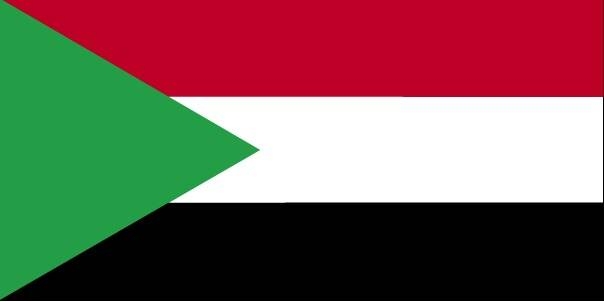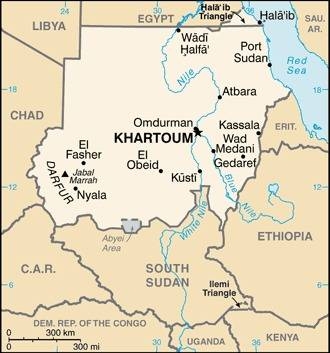224 Sudan

Three equal horizontal bands of red (top), white, and black with a green isosceles triangle based on the hoist side. Colors and design based on the Arab Revolt flag of World War I, but the meanings of the colors are expressed as follows: red signifies the struggle for freedom, white is the color of peace, light, and love, black represents the people of Sudan (in Arabic ‘Sudan’ means black), green is the color of Islam, agriculture, and prosperity.
Flag courtesy of the CIA World Factbook

Map courtesy of the CIA World Factbook

Pyramids of the Kushite rulers at Meroe.
Photo courtesy of the CIA World Factbook
Government
According to Britannica, since independence in 1956, Sudan has witnessed several constitutions and regime changes, including military coups in 1985, 1989, and 2019. The country’s 2005 interim constitution was suspended after the April 2019 coup. Later that year, the military and an alliance of civilian groups known as the Forces for Freedom and Change (FFC) signed a constitutional declaration that outlined a power-sharing agreement between the two sides and provided a road map for governing the country until a democratically elected government could be installed, with elections expected to be held in 2022.
Under the constitutional declaration, a transitional Sovereignty Council composed of five military and six civilian members was established. A military general was chosen to lead the council for the first 21 months, after which a civilian would lead. A prime minister, chosen by the FFC, appointed a cabinet, candidates for which were selected from a list proposed by the FFC, other than two who were appointed by military leaders on the council. A legislative assembly of no more than 300 members was provided for but not immediately formed.
A military coup in October 2021 led to the dissolution of the Sovereignty Council. Expected elections were pushed back to July 2023. The military formed a new Sovereignty Council, led by a general, in November 2021 that later reinstated the previous prime minister but did not include any FFC members and was not supported by them or many other civilian groups and political parties.
For administrative purposes, Sudan is divided into 18 states. Each state is administered by a governor.
Civil justice is administered through the Supreme Court, appeals courts, and courts of first instance. There is also a Constitutional Court.
Sudan Civil Aviation Authority (SCAA)
Sudan Civil Aviation Authority (SCAA) is responsible for air safety, air transport, air navigation, and aviation security.
Airspace
SkyVector – Google Maps – ADS-B Exchange
ICAO countries publish an Aeronautical Information Publication (AIP). This document is divided into three parts: General (GEN), En Route (ENR) and Aerodromes (AD). ENR 1.4 details the types of airspace classes they chose to adopt from classes A through G.
2018 – New Airspace Announcement
2011- Sudan Civil Aviation Regulations (SUCAR) 4 – Aeronautical Charts
Drone Regulations
Sudan Civil Aviation Regulations (SUCAR) 6.6 – Aerial Work – 2021
Sudan Civil Aviation Regulations (SUCAR) 2 – Rules of the Air – 2020
Advanced Air Mobility (AAM) Regulations & Policies
None found by the author.
However, should you, the reader, happen to stumble across something to the contrary, please email the author at FISHE5CA@erau.edu and you may be mentioned in the ACKNOWLEDGEMENTS section of this book by way of thanks for contributing to this free eBook!
Advanced Air Mobility (AAM) News
None found by the author.
However, should you, the reader, happen to stumble across something to the contrary, please email the author at FISHE5CA@erau.edu and you may be mentioned in the ACKNOWLEDGEMENTS section of this book by way of thanks for contributing to this free eBook!
Short Essay Questions
Scenario-Based Question
You have been hired by a Drone Startup Company. Your boss has immediately assigned this job to you.
They need you to prepare a one-page memo detailing the legalities of using a drone to film the pyramids pictured above.
They need you to mention any national laws and local ordinances.
They specifically want to know what airspace (insert pictures) you will be operating in and whether or not you need an airspace authorization.
Does it matter whether or not you are a citizen of the country?
Lastly, there is a bonus for you if, as you scroll through this chapter, you find any typos or broken links!
Short Essay Questions
- What are the drone categories?
- How is registration addressed?
- How is remote ID addressed?
- What are the model aircraft rules?
- What are the commercial drone rules?
- Are there waivers or exemptions to the rules? If so, for what?
- Would you share a link to an interactive airspace map?
- How is BVLOS addressed?
- How can you fly drones at night?
- How can you fly drones over people?
- Where do you find drone NOTAMs?
- What are the rules for drone maintenance?
- What are the rules for an SMS program?
- What are some unique rules not mentioned above?
- What are the C-UAS rules?
- What are the AAM rules?

